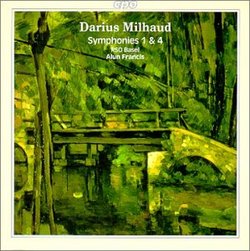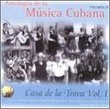| All Artists: Darius Milhaud, Alun Francis, Basel Radio Symphony Orchestra Title: Milhaud: Symphonies Nos. 1 & 4 Members Wishing: 0 Total Copies: 0 Label: Cpo Records Release Date: 9/29/1998 Genre: Classical Styles: Historical Periods, Modern, 20th, & 21st Century, Symphonies Number of Discs: 1 SwapaCD Credits: 1 UPC: 761203953929 |
Search - Darius Milhaud, Alun Francis, Basel Radio Symphony Orchestra :: Milhaud: Symphonies Nos. 1 & 4
 | Darius Milhaud, Alun Francis, Basel Radio Symphony Orchestra Milhaud: Symphonies Nos. 1 & 4 Genre: Classical
|
Larger Image |
CD DetailsSimilar CDs
|
CD ReviewsAn introduction to the symphonies of Milhaud Russ | Richmond, VA | 07/07/2006 (4 out of 5 stars) "With thirteen symphonies to his credit, Darius Milhaud (1892-1974) can probably be considered the leading French symphonist of the twentieth century. In describing his influences, Milhaud stated "My musical culture is determined exclusively by Latin-Mediterranean civilization, which is already explained by the fact that I come from a very old Jewish family of the Provence. Mediterranean music, especially Italian music, has always said a great deal to me; German music as good as nothing." I think this is pretty accurate, as Milhaud's music is as far away from Bruckner and Wagner as you can get.
Milhaud's music is primarily lighthearted and is filled with lots of skipping rhythms and colorful orchestration. The music often shifts in texture and in mood, often quite unexpectedly, as if Milhaud lost interest in what he was doing and wanted to try a new idea. Milhaud utilizes a highly contrapuntal style, not completely different from the contrapuntal style utilized by Villa-Lobos in his symphonies, with violins swirling about, often at the tip top of their range, while the brass or woodwinds are doing something else altogether. Milhaud's music is generally tonal, but with so much occurring at the same time, dissonances abound. This style is not universally appealing, as it demands a great deal from the listener. Depending on my mood, I may describe this music as sunny and interesting, or (if I am not in the mood) rambling and distracting. One thing for certain, you have to pay 100% of your attention to get the most out of it. Symphony No.1, despite being his first, is not an amateur work (it was composed when Milhaud was in his late forties) and was written in the United States. The first movement is called "Pastoral" but this is quite a different pastoral movement in comparison to, say, Vaughan Williams. I would describe the movement as jovial or carefree. The second movement is quicker and begins with pounding drums and lots of sudden shifts in dynamics and mood. The slow movement (I would say this applies more or less throughout the symphony cycle) plods along with a general lack of memorable melodic material; however there is some nice solo playing in woodwinds. The symphony concludes with a jaunty finale, with flutes skipping along in compound meter. The whole thing concludes with the violins and woodwinds skipping along above an unrelated broader theme. Symphony No. 4 was written to commemorate the one hundredth anniversary of the 1848 revolution. This symphony is more martial in comparison to his other symphonies, with the inclusion of a prominent drum part. The first movement is called "L'insurrection" and contains a rousing trumpet theme. Again, the slow movement seems, at least to me, a little dull. In comparison to the first movement, which often has four or five melodic ideas occurring simultaneously, this movement seems dead in the water with usually no more than a solo flute or clarinet wandering aimlessly above a droning part in the low strings. This is only interrupted by (and this is a personal pet peeve) a series of sudden dissonant brass chords, played forte or course. The third movement skips along amiably but ends quite unexpectedly. The finale ("Commemoration 1948") marks the return of the pounding drums. Once again, melodic ideas are all over the place, with an especially prominent part for the trumpet. Milhaud concludes the piece with the drums pounding a march theme that was heard at the beginning of the movement. In summary, this CD would make a good acquisition for anyone wanting to sample this composer. If you already know Milhaud, and like what he's about, this CD gets my highest recommendation, as the sound quality is excellent and the playing by the Radio-Sinfonieorchester Basel is very good. 53:26" |

 Track Listings (8) - Disc #1
Track Listings (8) - Disc #1

